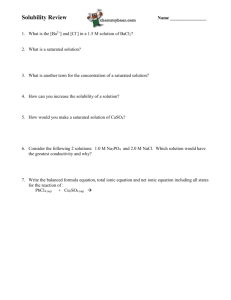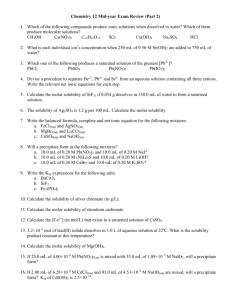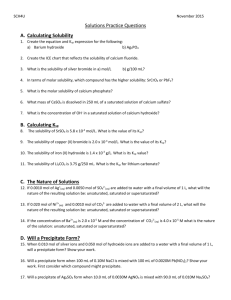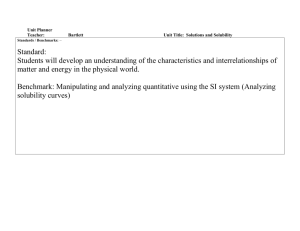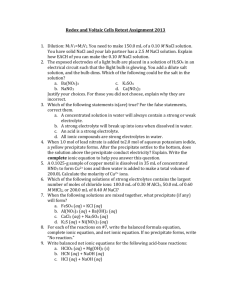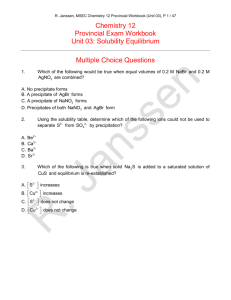Solubility Review
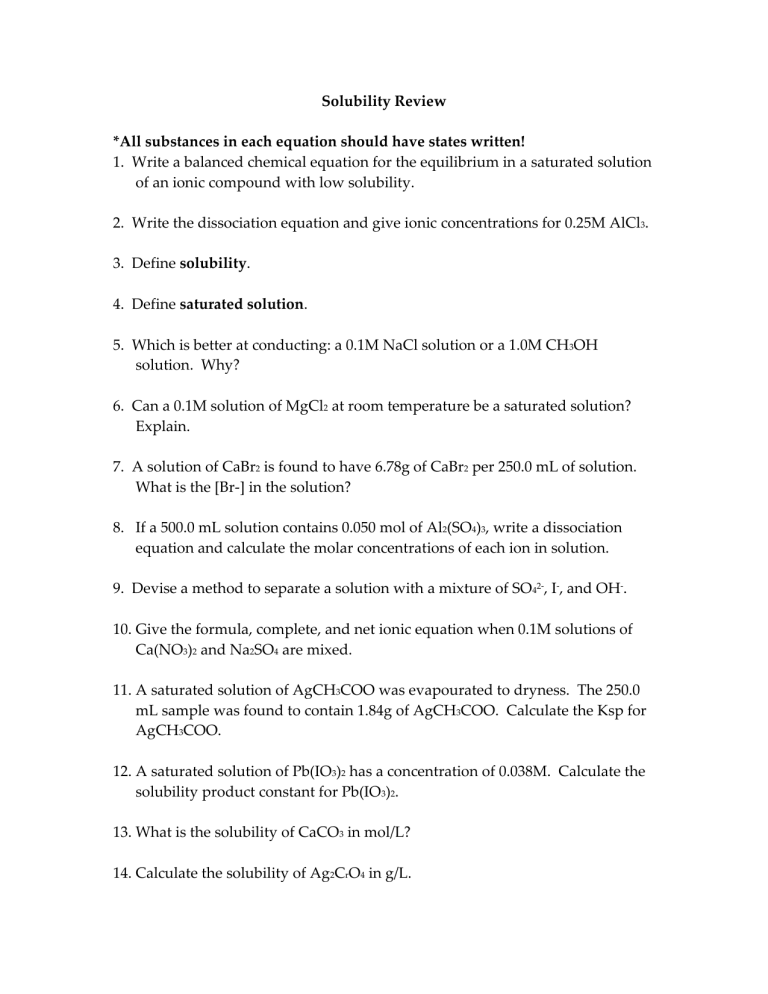
Solubility Review
*All substances in each equation should have states written!
1. Write a balanced chemical equation for the equilibrium in a saturated solution of an ionic compound with low solubility.
2. Write the dissociation equation and give ionic concentrations for 0.25M AlCl
3
.
3. Define solubility.
4. Define saturated solution.
5. Which is better at conducting: a 0.1M NaCl solution or a 1.0M CH
3
OH solution. Why?
6. Can a 0.1M solution of MgCl
2
at room temperature be a saturated solution?
Explain.
7. A solution of CaBr
2
is found to have 6.78g of CaBr
2
per 250.0 mL of solution.
What is the [Br-] in the solution?
8. If a 500.0 mL solution contains 0.050 mol of Al
2
(SO
4
)
3
, write a dissociation equation and calculate the molar concentrations of each ion in solution.
9. Devise a method to separate a solution with a mixture of SO
42-
, I , and OH .
10. Give the formula, complete, and net ionic equation when 0.1M solutions of
Ca(NO
3
)
2
and Na
2
SO
4
are mixed.
11. A saturated solution of AgCH
3
COO was evapourated to dryness. The 250.0 mL sample was found to contain 1.84g of AgCH
3
COO. Calculate the Ksp for
AgCH
3
COO.
12. A saturated solution of Pb(IO
3
)
2
has a concentration of 0.038M. Calculate the solubility product constant for Pb(IO
3
)
2
.
13. What is the solubility of CaCO
3
in mol/L?
14. Calculate the solubility of Ag
2
C r
O
4
in g/L.
15. Calculate the maximum mass (g) of CaSO
4
that could dissolve in 50.0L of water.
16. Will a precipitate form if 30.0 mL of 0.054M Ca(NO
3
)
2
is mixed with 60.0 mL of 8.1 x 10 -4 M Na
2
SO
4
?
17. Will a precipitate form when 90.0 mL of 1.00 x 10 -2 M Cu(NO
3
)
2
and 10.0 mL of
1.00 x 10 -2 M NaIO
3
are mixed? Explain using appropriate calculations.
18. Calculate the maximum moles of Br that can be added to 0.500L of 0.10M
Pb(NO
3
)
2
so a precipitate just starts to form. Then write the net ionic equation for the precipitate formation.
19. Calculate the maximum mass of Pb(NO
3
)
2
that could be dissolved in 100.0 mL of 0.100M NaCl without forming a precipitate.
20. Consider the following equilibrium:
MgCO
3(s)
Mg 2+(aq) + CO
32-(aq)
When solid Ca(NO
3
)
2
is added, more MgCO
3
dissolves. Explain.
21. In which of the following is Ag
2
C
2
O
4
likely to be least soluble: pure water,
0.10M K
2
CrO
4
, or 0.10M AgNO
3
? Explain.
22. A saturated solution of CaSO
4
is prepared by adding excess solute to water.
a) Write an equation that represents the saturated solution.
b) Identify a soluble salt that when added to the equilibrium in a) would cause more solid to dissolve. Explain how this would work.
23. A student adds Ag + to a solution containing 0.10M Cl and 0.10M CO
32-
.
Determine the colour of the first precipitate to form, given the following data:
AgCl white ppt Ksp = 1.8 x 10 -10
Ag
2
CO
3
yellow ppt Ksp = 8.5 x 10 -12
*Hint: use type D strategy
24. In an experiment a student pipettes a sample of saturated MgBr
2
solution into a beaker and evapourates the sample to dryness. The following data is recorded: Volume of saturated MgBr
2
: 25.00mL
Mass of Beaker: 89.05g
Mass of Beaker and solid 93.47g
Calculate the solubility of MgBr
2
in moles per litre.
